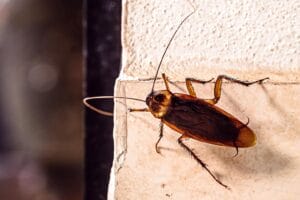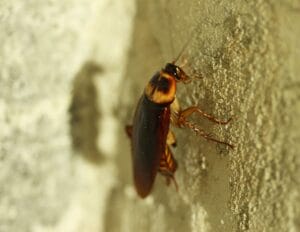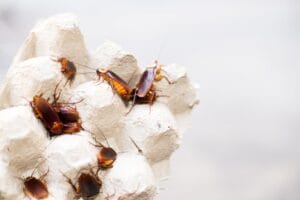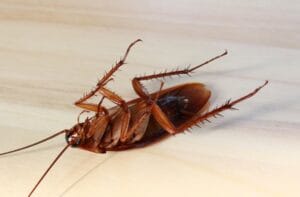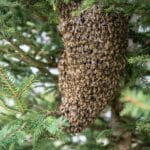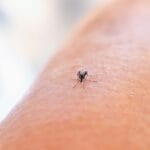Article-at-a-Glance
- Identify common types of cockroaches to safeguard your home against infestations.
- Learn the distinctive features and habitats of German, American, Oriental, and Brown-banded cockroaches.
- Understand cockroach behaviors, such as their activity cycles, dietary preferences, and rapid reproduction.
- Recognize the health risks and property damage associated with cockroach infestations.
- Discover effective pest control strategies, including DIY tips and when to call in professionals.
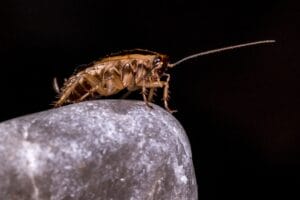
Dealing with cockroaches is more than a mere inconvenience; it’s about protecting your health and home. Recognizing these unwelcome visitors is the first step in reclaiming your space. Let’s dive into the world of cockroaches and arm you with the knowledge to identify and evict these pests effectively.
Spot the Intruder: Home Cockroach Identification
Why should you care about identifying cockroaches in your home? Well, because not all roaches are created equal. Different types bring different problems, and knowing your enemy is half the battle won.
Why Homeowners Must Recognize Different Roaches
It’s crucial to understand which type of cockroach has invaded your home, as each species has unique behaviors and preferences. This knowledge is vital for effective control and prevention. Besides that, some species may pose a greater health risk than others due to their potential to spread diseases.
Top Suspects: Introducing Common Cockroach Culprits
When you hear the scuttle in the night or catch a glimpse of a shadowy figure in the kitchen, it’s time to investigate. Most commonly, you’ll be dealing with one of four types of cockroaches: German, American, Oriental, or Brown-banded. Each has its own tell-tale signs. For a more detailed exploration of these pests, consider reading the Cockroaches 101 guide.
Meet the Unwanted Guests: Types of Home Cockroaches
German Cockroach: The Kitchen Invader
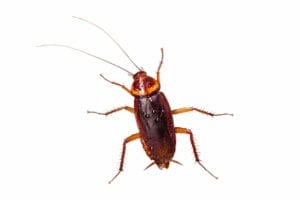
The German cockroach is notorious for its love of the kitchen. This small but mighty pest is a master of survival in indoor environments.
Distinctive Features
German cockroaches are light brown to tan, with two dark stripes on their backs. They’re smaller than their American cousins, but don’t let their size fool you. They reproduce quickly, making them a formidable opponent in the pest world.
Where You Might Find Them
- Near food sources, like the kitchen or pantry.
- In warm, humid areas such as under sinks or appliances.
- Hiding in cracks and crevices during the day.
These pests are attracted to moisture and warmth, which is why they’re often found lurking in kitchens and bathrooms. If you spot one, there are likely many more hidden away, so immediate action is needed.
American Cockroach: The Larger Loiterer
The American cockroach is the largest of the common household cockroaches, and it’s not shy about making its presence known.
Identifying Traits
This species is reddish-brown with a yellowish figure 8 pattern on the back of their heads. They prefer warm and damp environments but can survive in a variety of settings.
Typical Hangouts
American cockroaches are often found in basements, sewers, and drains. They can fly, which makes them particularly adept at finding their way into homes through open windows or doors.
These roaches are not just a nuisance; they can carry bacteria and pathogens that may lead to allergic reactions and asthma. Therefore, identifying and addressing an American cockroach problem swiftly is of utmost importance.
Oriental Cockroach: The Cooler Customer
The Oriental cockroach is a less common household intruder, but it’s one that thrives in cooler and damp environments.
Visual Identification
These roaches are dark brown to black, giving them their nickname “water bugs.” They are larger than German roaches but smaller than American ones, and they have a glossy body. Unlike others, they are poor climbers and are often found on lower levels of buildings.
Favored Habitats
- In basements or crawl spaces that are cool and damp.
- Near leaky water pipes, sinks, and laundry areas.
- Feeding on decaying organic matter, they’re less likely to be found near food prep areas.
Oriental cockroaches are slower moving and more sluggish than other species. This makes them somewhat easier to catch, but don’t be fooled, they’re just as eager to set up shop in your home if given the chance.
Brown-banded Cockroach: The Furniture Freeloader
This species is often mistaken for the German cockroach, but they have some distinct differences.
Unique Markings
Brown-banded cockroaches are identifiable by the two lighter bands they have across their dark brown bodies. They’re also one of the smaller species, which helps them hide more effectively in your home.
Habitual Preferences
- Prefer warmer, drier, and higher areas like upper cabinets or closets.
- Can be found in living rooms and bedrooms, not just the kitchen or bathroom.
- They often hide behind picture frames, in furniture, or electronics.
Unlike the German cockroach, which is more commonly found in the kitchen, Brown-banded cockroaches have a broader range and can infest any room in your home. They’re also less dependent on moisture, which means they can be a bit trickier to control.
Behavior Patterns: Understanding Cockroach Lifestyles
Now that we know who our culprits are, let’s talk about their lifestyles. Understanding their behaviors is key to keeping them out of your home.
Activity Cycles: When Roaches Roam
Cockroaches are nocturnal, meaning they’re active at night. If you see them during the day, it’s a sign of a large infestation. They spend their days hiding away in dark, secluded areas and come out to feed at night.
When the lights go off, the roaches come out. They’ll scavenge for food, water, and mates. It’s during this time that they’re most vulnerable to traps and baits. So, if you’re planning an ambush, night time is your best bet.
Dietary Choices: What Cockroaches Crave
Cockroaches aren’t picky eaters. They’ll consume anything from food crumbs to cardboard. This diverse diet helps them survive in many environments.
- Food scraps and spills are a feast for these pests.
- They also munch on paper products, glue, and even soap.
Keep your home clean and free of food debris to cut off their supply. It’s one of the simplest yet most effective ways to deter them.
Since they eat a wide range of things, they can survive in almost any environment. That’s why sanitation is so important in cockroach control.
Reproduction Rates: Prolific Pest Populations
Cockroaches reproduce at an alarming rate. A single female German cockroach, for example, can produce thousands of offspring in a year. This rapid reproduction makes it essential to address infestations quickly.
Once they’ve found a comfortable spot in your home, they’ll start multiplying, and before you know it, you could have a full-blown infestation on your hands. Regular inspections and prompt action at the first sign of cockroaches are crucial.
Risk and Wreckage: The Dangers of Cockroach Infestations
Cockroaches aren’t just unsightly; they pose serious risks to your health and home. Let’s explore why it’s so important to keep these pests at bay.
Health Hazards: Assessing the Risk
- Cockroaches can carry bacteria and viruses on their bodies, potentially causing illness.
- They can contaminate food and cooking surfaces as they forage.
- Their droppings, saliva, and shed skin can trigger allergies and asthma, especially in children.
Because cockroaches can spread germs and trigger allergies, it’s essential to control and prevent infestations for the health and safety of your family.
It’s not just about the “ick” factor; it’s about protecting your loved ones from the potential dangers these pests bring into your home.
Property Damage: Accounting for Destruction
Cockroaches can cause damage to your property, not just by being there but by what they leave behind.
- They can stain surfaces with their droppings.
- They can damage books, clothing, and wallpaper with their feeding.
When you consider the potential cost of repairing or replacing damaged items, investing in cockroach control seems like a no-brainer.
Allergies and Asthma: Hidden Health Impacts
One of the less known dangers of cockroaches is their impact on respiratory health. The allergens they produce can exacerbate asthma symptoms, particularly in children and sensitive individuals.
Keeping your home clean and free of cockroaches is not just about avoiding a nuisance; it’s about maintaining a healthy living environment.
Pest Control Tactics: Combat and Prevent Roach Residents
It’s clear that cockroaches are unwelcome houseguests, but how do you show them the door? Let’s talk about the best ways to keep your home roach-free.

Effective cockroach control involves a combination of good sanitation, habitat alteration, and the use of baits, traps, and insecticides. But most importantly, it’s about being proactive rather than reactive.
DIY or Professional? Making the Right Choice
While there are many DIY solutions for cockroach control, sometimes the infestation is too big or too persistent for home remedies. In these cases, it’s wise to call in the professionals.
Professionals have access to more potent treatments and can offer customized solutions for your specific situation. They also understand the biology and behavior of cockroaches, which allows them to target treatments effectively.
If you’re dealing with a large infestation, or if you’ve tried DIY methods without success, it’s time to call in the experts. They can provide the heavy artillery needed to reclaim your home from these resilient pests.
Prevention is your best bet when it comes to keeping cockroaches out of your home. Let’s explore some practical steps you can take to prevent these pests from becoming permanent residents.
Sealing Entry Points
Roaches can squeeze through the tiniest of gaps. To keep them out, you’ll need to:
- Inspect the exterior of your home for cracks and crevices.
- Use caulk to seal any openings around windows, doors, and foundation.
- Check for gaps around pipes and wires that enter your home and seal them up.
Remember, if a pencil can slide into a crack or gap, a young cockroach can too. Sealing your home not only keeps out roaches but also helps with energy efficiency.
Regular Inspections
Regularly inspect your home for signs of cockroaches, including:
- Fecal droppings, which look like pepper flakes.
- Egg cases (oothecae) or shed skins in hidden areas.
- A musty odor which can indicate a large infestation.
By keeping an eye out for these signs, you can catch an infestation early and take action before it gets out of hand.
Sealing the Deal: Ensuring a Roach-Free Home
Once you’ve taken preventive measures, it’s time to ensure your home remains roach-free. This means being vigilant and ready to tackle any new intruders promptly.
Effective Cockroach Baits and Traps
Baits and traps are an excellent way to control cockroach populations. For a deeper understanding, you can explore this complete guide to Cockroaches, which covers various methods of management including baits and traps.
- Baits contain poison mixed with attractive food for roaches, which they then take back to their nest.
- Traps can be used to monitor activity levels and identify problem areas.
- Place these products in areas where cockroaches are likely to travel or hide.
When used correctly, baits and traps can significantly reduce cockroach numbers and help keep your home pest-free.
Chemical Treatments: What You Need to Know
Chemical treatments can be effective but should be used with caution:
- Always follow the label instructions carefully.
- Consider using gel baits and insect growth regulators as part of your control strategy.
- Be aware that misuse of chemicals can lead to resistance in cockroach populations.
It’s essential to use these products responsibly to protect your family and the environment.
Long-Term Monitoring: Staying Vigilant
Even after you’ve dealt with an infestation, ongoing monitoring is key:
- Continue to use traps to watch for new cockroach activity.
- Maintain a clean and clutter-free home to make it less attractive to pests.
- Regularly check and refresh baits and traps as needed.
Staying on top of cockroach control will help prevent future infestations and keep your home safe and healthy.
Frequently Asked Questions
How can I tell if I have a cockroach infestation?
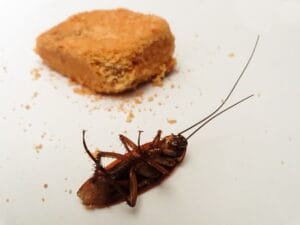
Look for these signs:
- Live or dead cockroaches, especially during the day.
- Cockroach droppings that resemble black pepper or coffee grounds.
- An oily or musty smell that wasn’t there before.
Spotting these signs means it’s time to take action and consider professional pest control help.
Are there any natural remedies to control cockroaches?
Yes, there are several natural remedies, such as:
- Boric acid, which is toxic to cockroaches when ingested.
- Diatomaceous earth, which damages the roach’s exoskeleton.
- Essential oils like peppermint or lemongrass as repellents.
While these remedies can help, they may not be enough for large infestations.
How often should I inspect my home for cockroaches?
Conduct thorough inspections at least once a season:
- Check common entry points and hiding spots.
- Look for any new cracks or crevices that may have developed.
- Keep an eye out for any signs of roach activity.
Regular inspections are crucial in catching problems early and keeping your home pest-free.
Can cockroaches become immune to pesticides?
Yes, cockroaches can develop resistance to pesticides, especially if the same chemicals are used repeatedly. To avoid this, consider integrating effective natural pest control methods into your pest management strategy.
- Rotate different types of control products.
- Combine chemical treatments with non-chemical methods.
- Work with a pest control professional who can provide a tailored solution.
Adopting a comprehensive approach is the best way to ensure effective long-term control.
Is it safe to use cockroach control products around children and pets?
Many products are safe when used according to the label instructions, but take these precautions:
- Choose baits and traps designed to be tamper-resistant.
- Store chemicals out of reach of children and pets.
- Consider non-toxic alternatives for sensitive areas.
Your family’s safety is paramount, so always err on the side of caution when using pest control products.
In conclusion, identifying and controlling cockroaches is an ongoing battle, but one that can be won with knowledge, vigilance, and the right tactics. By understanding the types of cockroaches, their behaviors, and the risks they pose, you can take proactive steps to keep your home safe and healthy. Remember, when in doubt, professional pest control services are your best ally in the fight against these resilient pests.
Option A.
